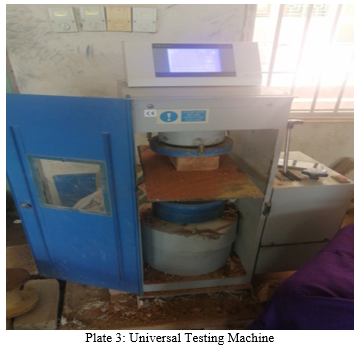Evaluation of production cost of bricks using clay and stone dust-cement
Keywords:
Production cost, Bricks, Stone Dust, building materialAbstract
This study aimed to investigate whether mixing clay soil, stone dust, and 5% cement could enhance strength, reduce water absorption, and lower production costs, without compromising the material's quality. Clay soil from near FUTA, Akure and stone dust from a quarry were used. Tests were conducted on the raw materials, including sieve analysis, moisture content, bulk density, and specific gravity. Clay soil was partially replaced with stone dust at 0% (control), 5%, 10%, 15%, 20%, and 25%, with a constant 5% cement. 288 bricks were produced, 144 air-dried and 144 fired at 1000°C. Compressive strength and water absorption tests were performed on both burnt and unburnt bricks. The results showed that for burnt bricks at 28 days, water absorption ranged from 11.11% to 20.00%, and for unburnt bricks, 3.33% to 7.69%. The compressive strength of burnt bricks increased up to 15% stone dust replacement, then decreased, while unburnt bricks showed a gradual strength reduction with increasing replacement. Both results met NIS and BS standards for normal building bricks.
Downloads
References
Zhang, Z., Wong, Y. C., Arulrajah, A., & Horpibulsuk, S. (2018). A review of studies on bricks using alternative materials and approaches. Construction and Building Materials, 188, 1101-1118.
Pimraksa, K., and Chindaprasirt, P. (2009). Lightweight bricks made of diatomaceous earth, lime and gypsum. Ceramics International, 35(1), 471-478.
Ural, N. (2018). The importance of clay in geotechnical engineering. London, UK: Intech Open, 83-90.
Smith, A.S., Bingel, P. and Bown, A., (2016). Mater., 46, 1–7.
Zhang, L., (2013). Production of Bricks from Waste Materials – A Review. Construction and Buildings Materials, 47, 643-655.
Djamil, B. (2016). Sun-dried clay for sustainable constructions. International Journal of Applied Engineering Research, 11(6), 4628-4633.
Yetgin, S., Cavdar, O. and Cavdar, A., (2008). The Effects of the Fiber Contents on the Mechanic Properties of the Adobes. Construction and Building Materials, 22(3), 222-227.
Aiyewalehinmi, E.O. and Aderinola, O.S. (2015). Strength Properties of Commercially Produced Clay Bricks in Six Different Location/States in Nigeria. Journal of Engineering (ISRJEN) USABS 1377.
Aiyewalehimi, E.O. and Tanimola, M.O. (2013). Strength Properties of Commercially Produced Sandcrete Block, Akure, Ondo State. International Journal of Engineering Science Invention (IJESI), 2, 22-33.
Chen, H., Wang, Q. (2006). The behaviour of organic matter in the process of soft soil stabilization using cement. Bulletin of Engineering Geology and the Environment, 65, 445–448 https://doi.org/10.1007/s10064-005-0030-1
Vijayan, D. S., Mohan, A., Revathy, J., Parthiban, D., & Varatharajan, R. (2021). Evaluation of the impact of thermal performance on various building bricks and blocks: A review. Environmental Technology & Innovation, 23, 101577.

Downloads
Published
How to Cite
Issue
Section
License
Copyright (c) 2025 IJANUSI Ebenezer Oluwafemi, AIYEWALEHINMI E. O., Funminiyi Oyekunle, ODOFIN Sunday Festus

This work is licensed under a Creative Commons Attribution 4.0 International License.
Copyright on any article in the International Journal of Engineering and Applied Physics is retained by the author(s) under the Creative Commons license, which permits unrestricted use, distribution, and reproduction provided the original work is properly cited.
License agreement
Authors grant IJEAP a license to publish the article and identify IJEAP as the original publisher.
Authors also grant any third party the right to use, distribute and reproduce the article in any medium, provided the original work is properly cited.
Most read articles by the same author(s)
- Funminiyi Oyekunle, Sanya OGUNSUSI, E.O. Aiyewalehinmi, Kunle AMOKO, Assessment of occupational health and safety risks in selected construction sites in oyo state, Nigeria , International Journal of Engineering and Applied Physics: Vol. 5 No. 1: January 2025
- Funminiyi Oyekunle, Prof. B. D. Oluyemi-Ayibiowu, Adeola Akinsuyi, Optimization of concrete produced from industrial waste and fibre using regresion model , International Journal of Engineering and Applied Physics: Vol. 4 No. 3: September 2024














